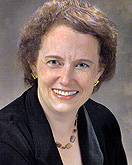News
Social Work heads into cyberspace
-
 Print
Print -
 Comments
Comments
-

“We risk becoming obsolete if we do not get on board with this.”
The School of Social Work has put its ambitions to be a national leader in using digital technologies to teach the social work profession where they belong—online.
Whether it means nationally acclaimed podcasts or the emerging alternative digital world of Second Life, UB’s School of Social Work is online in a major way. The school, which recently was ranked by U.S. News and World Report in the top 20 percent of social work colleges in the country—10 positions higher than the magazine’s previous survey—now has four distinct and comprehensive cyberspace initiatives designed to meet the cyberspace community on its own electronic turf.
“As a profession, social workers are latecomers to technology. As latecomers, we’re missing a generation,” says Nancy J. Smyth, dean of the School of Social Work. “We risk becoming obsolete if we do not get on board with this.
“Our strategy is to go more digital,” she says. “Recruitment of students is shifting more and more to online strategies. Go electronic. That’s certainly true for trying to recruit new students. The need to develop an electronic cyberspace presence is a given.”
So Smyth has pushed hard for the School of Social Work to go digital, often leading by example. Other colleges and universities might share the school’s intentions, but few can match UB’s growing list of accomplishments.
“Living Proof,” the school’s podcast series, has grown into a regular biweekly feature. Hosted by Adjoa Robinson, assistant professor of social work, the online feature has included a three-part series on caring for people who are dying, the role of social workers in the justice system and the effects of trauma, both psychological and physiological.
“All of the podcasts have slightly different audiences,” says Smyth. “And you have to create something of substance. The podcasts have become a major vehicle for us to expand ourselves to an international community and to reach students at other schools by providing a needed service.”
Smyth notes that the UB School of Social Work is the only school of social work in the country with a podcast series.
The school’s other digital forays include:
• Facebook. Many people with ties to the School of Social Work may have noticed a new friend that pops up on their Facebook page. A quick glance at the online photo shows it’s their school’s dean. Smyth maintains an active and diverse Facebook page.
The school also nurtures its own active Facebook page. “Living Proof: University at Buffalo School of Social Work.” Its creators saw it as a crossroads for current students, faculty, alumni and those who wanted to interact with these groups to network—for everything from current research to professional contacts.
“Facebook is a way to connect to alumni and to help students connect with alumni prior to graduation,” Smyth says. “And we’re beginning to connect to alumni that the university hasn’t been able to find.”
• Online courses. Smyth has encouraged an expanded menu of online courses, steadily adding to the online course load until there will be four completely cyberspace classes this fall and more courses that are “hybrids,” a combination of online and face-to-face instruction.
“For our students who live farther away, these courses have to do with travel and accessibility,” says Denise Krause, clinical associate professor and associate dean for community engagement, who teaches two online courses. “For others who don’t have a lot of travel, they want flexibility, which is attractive if they’ve got a lot going on in their lives.”
Then there is Second Life, the pseudo-mysterious and still somewhat misunderstood virtual world those familiar with it say resembles a Sims life-simulated computer game, but with significantly more depth and possibility. Charles D. Syms, clinical associate professor of social work, has been investigating how the school can use Second Life. He says plans are exploratory at this time. But other research and educational agencies have used the intricate and digitally sophisticated virtual world to do everything from cyberspace training sessions to maintaining long-standing “avatars”—characters that exist in Second Life with presences that reflect their profession. Syms is working on establishing these avatars with a social-work orientation.
“We would hope someday to use Second Life to extend the classroom so you can set up scenarios where people can relate to one another in situations that are much more real than talking about it in the classroom,” he says. “There’s a lot of potential for learning over a long distance.”
And besides, Syms says, it can be a lot of fun.
“We’re letting people know who we are,” he adds. “We’re trying to establish a presence to reach those who may know nothing about social work, but who should.”

Reader Comments